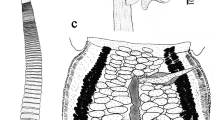Abstract
Liocypris grandis, a Red Data List species, presumed extinct, has been found for the first time since its original description in 1924 in the Western Cape Province in South Africa, in an area about 200 km NE from its type locality. The species is redescribed. Apart from the seven paired appendages, normal for the Podocopida, five additional paired appendages also occur. As these structures do not occur in the (A-1) female juvenile stage, the significance of these structures is deemed to be reproductive. Owing to this association with the (female) genital organs, these structures are here termed R1–R5. Their putative homology is discussed; it is deduced that, contrary to earlier claims, the (female) genital organs in ostracods might be homologous to more than one (thoracic) limb, in this case 3–5 limbs and segments. The structures are either non-functional relicts, or are functional with regard to brood care or mating behaviour. The phylogenetic signal delivered by the presence of these structures is highly obscure; they could be from most ancestral to highly derived, even independent of the phylogenetic position of Liocypris itself. The presence of these R-appendages, together with some other features, provokes the erection of Liocypridinae subfam.n. within the family Cyprididae.
Similar content being viewed by others
References
Bate, R. H., 1972. Phosphatised ostracods with appendages from the lower Cretaceous of Brasil. Palaeontology 15: 379–393.
Broodbakker, N. W. & D. L. Danielopol, 1982. The chaetotaxy of Cypridacea (Crustacea, Ostracoda) limbs: proposals for a descriptive model. Bijdr. Dierk. 52: 103–120.
Cohen, A. C. & J. G. Morin, 1990. Patterns of reproduction in ostracodes: a review. J. crust. Biol. 10: 184–211.
Cohen, A. C. & J. G. Morin, 1993. The cypridinid copulatory limb and a new genus Kornickeria (Ostracoda, Myodocopida) with four new species of bioluminiscent ostracods from the Caribbean. Zool. J. linn. Soc. 108: 23–84.
Cohen, A. C. & J. G. Morin, 1997. External Anatomy of the female genital (eight) limbs and the setose openings in myodocopid ostracodes (Cypridinidae). Acta Zool. 78: 85–96.
Fryer, G., 1987. A new classification of the branchiopod Crustacea. Zool. J. linn. Soc. 91: 357–383.
Fryer, G., 1999. The case of the one-eyed brine shrimp: are ancient atavisms possible? J. nat. Hist. 33: 791–798.
Grékoff, N., 1957. Ostracodes du Bassin du Congo. I. Jurassique Supérieur et Crétacé inférieur du Nord du Bassin. Annales du Musée Royal du Congo Belge, Ser 8, Sciences Géologiques 35: 170 pp, 25 plts.
Horne, D. J., D. L. Danielopol & K. Martens, 1998. Reproductive behaviour in non-marine ostracods. In Martens, K. (ed.), Sex and Parthenogenesis – Evolutionary Ecology of Reproductive Modes in Non-Marine Ostracods. Leiden: Backhuys Publ. 157–195.
Horne, D. J., A. Cohen & K. Martens, 2002. Biology, Taxonomy and Identification Techniques. In Holmes, J. A. & A. Chivas (eds), The Ostracoda: Applications in Quaternary Research. Washington DC: American Geophysical Union: 5–36.
Kaufmann, A., 1896. Die Schweizerischen Cytheriden und ihren nächsten Verwandten. Rev. Suisse Zool. 4: 313–384.
Maddocks, R., 1982. Part 4. Ostracoda. In Abele, L. G. (ed.), The Biology of Crustacea, 1; Systematics, the Fossil Record and Biogeography. Academic Press: 221–239.
Martens, K., 1987. Homology and functional morphology of the sexual dimorphism in the antenna of Sclerocypris Sars, 1924 (Crustacea, Ostracoda, Megalocypridinae). Bijdr. Dierk. 57: 183–190.
Martens, K., 1990. Revision of African Limnocythere s.s. Brady, 1867 (Crustacea, Ostracoda) with special reference to the Eastern Rift Valley Lakes: morphology, taxonomy, evolution and (palaeo) ecology. Archiv Hydrobiol. Suppl. 83: 453–524.
Martens, K., 1998. Diversity and endemicity of Recent non-marine ostracods (Crustacea, Ostracoda) from Africa and South America: a faunal comparison. Verh. int. Ver. Limnol. 26: 2093–2097.
Martens, K., 2000. Factors affecting the divergence of mate recognition systems in the Limnocytherinae (Crustacea, Ostracoda). Hydrobiologia 419: 83–101.
Martens, K. (in press). On the evolution of Gomphocythere (Crustacea, Ostracoda) in Lake Nyassa/ Malawi (East Africa), with the description of five new species. Hydrobiologia (accepted).
Martens, K., D. J. Horne & H. I. Griffiths, 1998. Age and diversity of non-marine ostracods. In Martens, K. (ed.), Sex and Parthenogenesis – Evolutionary Ecology of Reproductive Modes in Non-Marine Ostracods. Leiden: Backhuys Publ. 37–55.
Meisch, C., 2000. Freshwater Ostracoda of western and central Europe. Süsswasserfauna von Mitteleuropa 8/3. Spektrum Akad. Verlag / Gustav Fischer, Heidelberg: 522 pp.
Moore, R. C., 1961. Crustacea, Ostracoda. In Treatise on Invertebrate Paleontology, Geological Society of America. 442 pp.
Park, L. E. & K. Martens, 2001. Four new species of Gomphocythere (Crustacea, Ostracoda) from Lake Tanganyika, East Africa. Hydrobiologia 450: 129–147.
Sars, G. O., 1924. The fresh-water Entomostraca of the Cape Province (Union of South Africa). Part 2: Ostracoda. Ann. S. Afr. Mus. 20: 105–193.
Smith, R. J., 2000. Morphology and ontogeny of Cretaceous ostracods with preserved appendages from Brazil. Palaeontology 43: 63–98.
Smith, R. J. & K. Martens, 2000. The ontogeny of the cypridid ostracod Eucypris virens (Jurine, 1820) (Crustacea, Ostracoda). Hydrobiologia 419: 31–63.
Swanson, K. M., 1989. Manawa staceyi n.sp. (Punciidae, Ostracoda): soft anatomy and ontogeny. Courier Forschungsinstitut Senckenberg 113: 235–249.
Swanson, K. M., 1990. The punciid ostracod – a new crustacean evolutionary window. Courier Forschungsinstitut Senckenberg 123: 11–18.
Tsukagoshi, A. & A. R. Parker, 2000. Trunk segmentation of some podocopine lineages in Ostracoda. Hydrobiologia 419: 15–30.
Whitting, M. F., S. Bradler & T. Maxwell, 2003. Loss and recovery of wings in stick insects. Nature 421: 264–267.
Author information
Authors and Affiliations
Rights and permissions
About this article
Cite this article
Martens, K. On a remarkable South African giant ostracod (Crustacea, Ostracoda, Cyprididae) from temporary pools, with additional appendages. Hydrobiologia 500, 115–130 (2003). https://doi.org/10.1023/A:1024684318274
Issue Date:
DOI: https://doi.org/10.1023/A:1024684318274




